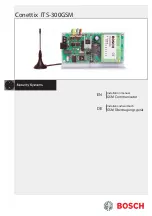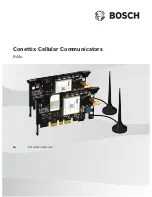
A generic, high-level functional block diagram of U310 is shown in Figure 1-1. One antenna collects
base station forward link signals and radiates handset reverse link signals.
The antenna connects with receive and transmit paths through a switch module (plus a duplexer for
UMTS-2100 operation).
UMTS band signals at the antenna are switched to the relevant UMTS duplexer. The UMTS receive
band signals are amplified by the front-end LNAs of the RFR6250 IC before passing through a band-
pass filter and being applied to the mixer inputs of the RFR6250 IC.
On-chip circuits down-convert the received signal directly from RF to baseband using radioOne Zero-
IF techniques. Generation and distribution of the UMTS LO, for the downconverter, is performed
entirely on-chip (except for the loop filter). The RFR6250 IC outputs analog baseband signals for
processing by the MSM device. This baseband interface is shared with the RTR6250 GSM receiver
outputs, but is separate from the GPS baseband interface.
EGSM, DCS and PCS receive signals from the antenna switch module pass through their band-pass
filters, then are applied to the RTR6250 IC. In a similar fashion to the UMTS paths, RTR6250 IC
circuits down-convert the received signals directly from RF to baseband. The GSM LO for multiband
down conversion is entirely generated within the RTR6250 IC (PLL and distribution functions) with
exception of the off-chip loop filter.
The RTR analog baseband outputs are routed to the MSM6250A IC for further processing (an
interface shared with the RFR UMTS receive paths).
The UMTS transmit path begins with analog baseband signals from the MSM device that drive the
RTR6250 IC. Integrated PLL and VCO circuits generate the Tx LO used in the quadrature upconverter
that translates baseband signals directly to RF. The RTR6250 output driver stages deliver fairly high-
level signals that are filtered and applied to the power amplifiers (PA). The PA output is routed to the
antenna through a duplexer and switch module.
The shared EGSM-900, DCS-1800, and PCS-1900 transmit path begins with the same baseband
interface from the MSM6250A IC that is used for the UMTS band. A single EGSM/DCS/PCS
quadrature upconverter translates the GMSK-modulated signal to a convenient intermediate frequency
(IF) that forms one input to an offset phase-locked loop (OPLL). OPLL functions are split between the
RTR6250 IC and off-chip loop filter and dual Tx VCO circuits, and translate the GMSK-modulated
signal to the desired EGSM-900, DCS-1800 or PCS-1900 channel frequency. This signal is applied to
a dual power amplifier (only one is active at a time). The enabled path continues with the PA, an
automated power control (APC) circuit that samples the transmit power and adjusts its level, the switch
module (which includes a band-appropriate lowpass filter), and the antenna.
3. TECHNICAL BRIEF
- 18 -
Содержание U310
Страница 3: ... 4 ...
Страница 20: ...3 TECHNICAL BRIEF 21 ...
Страница 33: ...3 TECHNICAL BRIEF 34 Figure 3 5 10 1 Bluetooth system architecture ...
Страница 47: ...3 TECHNICAL BRIEF 48 Figure PM6650 2M Functional Block Diagram ...
Страница 72: ...4 TROUBLE SHOOTING 73 4 2 SIGNAL PATH WCDMA Tx PATH WCDMA Rx PATH ...
Страница 76: ...4 TROUBLE SHOOTING 77 ...
Страница 90: ...4 TROUBLE SHOOTING 91 ...
Страница 110: ...4 TROUBLE SHOOTING 111 CN501 C537 C538 MSM6250A ...
Страница 116: ...4 TROUBLE SHOOTING 117 C216 C217 for MIC serial capacitor MSM6250A ...
Страница 119: ...4 TROUBLE SHOOTING 120 Q400 Q401 Q402 VBATT GND ...
Страница 149: ... 150 8 pcb layout ...
Страница 150: ... 151 8 pcb layout ...
Страница 151: ... 152 8 pcb layout ...
Страница 152: ... 153 8 pcb layout ...
Страница 153: ... 154 ...
Страница 160: ...9 Calibration RF Auto Test Program 161 9 3 1 Example for Calibration Click START U310 ...
Страница 161: ...9 Calibration RF Auto Test Program 162 9 3 2 Example for RF Auto Test Click Run button U310 U310 U310 U310 ...
Страница 163: ... 164 ...
Страница 187: ...Note ...
Страница 188: ...Note ...
















































